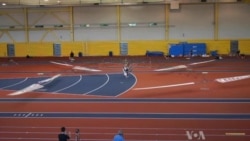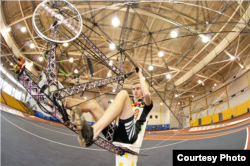Students at the University of Maryland want to make aviation history by building the world's first human-powered helicopter.
In 1980, the American Helicopter Society announced an award for the first person to accomplish such a feat.
The $250,000 Sikorsky Prize would go to a vehicle that could hover for 60 seconds, not stray beyond a three-meter-square area, and at some point in the flight reach an altitude of three meters.
The prize has gone unclaimed for 33 years, but the student engineers are confident they can bring it home.
Within reach
What seemed impossible when William Staruk began his PhD studies at the University of Maryland three years ago, is now within reach. He's part of a 50-member team developing a flyer called the Gamera II.
“It has flown for 60 seconds and on a different flight gone to an altitude of nine feet [2.7 meters]." Staruk said. "We’re hoping now to combine both of those into a single flight, get that little bit of extra altitude we need and keep the helicopter controlled and stable so that we can take home the $250,000 Prize.”
The volunteers are divided into the rotor, cockpit, transmission and stability working groups. Weight is a major concern for all of them. The 36-kilogram craft is shaped like a giant x, with 21-meter long arms that look like railroad trusses.
“Everything on the helicopter that is black is carbon fiber," Staruk said. "The blades you see are largely white. That’s insulation foam. It’s a lightweight material that we can use to hold the shape of our blades. Those blades are covered in a skin that is Mylar. It is a clear plastic that forms the surface of the wings. ”
Staruk says unlike a normal helicopter with blades on the top and tail, the 4 rotors on the Gamera II - each with two blades at the tips of each cross-piece - are close to the ground.
“So, by keeping our blades low they actually take less power to run," he said. "As we climb, it gets harder and harder for the pilot. That's what limits our altitude.”
The pilot sits suspended under the center of the X, with his feet clipped into bike-like pedals and his hands on a crank. A lightweight cord runs from the wheels spun by the pedals, through the craft, to the rotors.
“As the pilot pedals, it reels in the string just like reeling in a fish," Staruk said. "When the pilot cranks his hands and feet, the rotors all start spinning at the same speed and that lifts us into the air.”
Test Day
On flight test days, PhD student Elizabeth Weiner stands under the craft, yelling commands to the pilot and support team. Disappointed with Gamera II’s latest performance just a few weeks ago, she’s come to the warehouse where it’s stored to inspect the damage.
“There’s a lot of fatigue that happens on all the parts of the helicopter," Weiner said. "And so one of the things that we’re doing now is post-flight testing, going through and making sure that nothing else is broken. We had some problems with blades. But you never know what else is slowly breaking.”
Colin Gore also stops by for a look. He’s a student in materials science and knew little about helicopters before joining the team. But he is thin, 54.4 kilograms, and strong, which made him the perfect test pilot.
“I'm a pretty slim guy, but ’ve got a lot of muscle compared to the rest of my body," Gore said. "I feel like I've got a high profile but probably, I’ve got the easiest job of all of them, just dump power into it and give them the performance that they deserve.”
Meeting the challenge
Despite recent setbacks, Gore’s motivation is shared by his team members. Staruk and Weiner agree that it has been a great run.
“We’ve had the opportunity to go through an actual design and flight test experience and that’s the sort of thing you never get to do," Staruk said. "It’s a lot of fun going out there and building something and flying it and trying to do the impossible”
“For me," Weiner said, "it’s knowing that we did it and we did it first.”
And they are doing it, after being challenged to enter the competition four years ago by aerospace professor Inderjit Chopra. He’s watched as the students invested time and creativity in the project. He’s proud of what they’ve accomplished and what they are about to do.
“This milestone has not been successfully completed yet," Chopra said. "It will be an enormous joy when they complete it. I hope that it should be in 2013.”
The Gamera II team plans to make another attempt at the Sikorsky Prize within two months.
In 1980, the American Helicopter Society announced an award for the first person to accomplish such a feat.
The $250,000 Sikorsky Prize would go to a vehicle that could hover for 60 seconds, not stray beyond a three-meter-square area, and at some point in the flight reach an altitude of three meters.
The prize has gone unclaimed for 33 years, but the student engineers are confident they can bring it home.
Within reach
What seemed impossible when William Staruk began his PhD studies at the University of Maryland three years ago, is now within reach. He's part of a 50-member team developing a flyer called the Gamera II.
“It has flown for 60 seconds and on a different flight gone to an altitude of nine feet [2.7 meters]." Staruk said. "We’re hoping now to combine both of those into a single flight, get that little bit of extra altitude we need and keep the helicopter controlled and stable so that we can take home the $250,000 Prize.”
The volunteers are divided into the rotor, cockpit, transmission and stability working groups. Weight is a major concern for all of them. The 36-kilogram craft is shaped like a giant x, with 21-meter long arms that look like railroad trusses.
“Everything on the helicopter that is black is carbon fiber," Staruk said. "The blades you see are largely white. That’s insulation foam. It’s a lightweight material that we can use to hold the shape of our blades. Those blades are covered in a skin that is Mylar. It is a clear plastic that forms the surface of the wings. ”
Staruk says unlike a normal helicopter with blades on the top and tail, the 4 rotors on the Gamera II - each with two blades at the tips of each cross-piece - are close to the ground.
“So, by keeping our blades low they actually take less power to run," he said. "As we climb, it gets harder and harder for the pilot. That's what limits our altitude.”
The pilot sits suspended under the center of the X, with his feet clipped into bike-like pedals and his hands on a crank. A lightweight cord runs from the wheels spun by the pedals, through the craft, to the rotors.
“As the pilot pedals, it reels in the string just like reeling in a fish," Staruk said. "When the pilot cranks his hands and feet, the rotors all start spinning at the same speed and that lifts us into the air.”
Test Day
On flight test days, PhD student Elizabeth Weiner stands under the craft, yelling commands to the pilot and support team. Disappointed with Gamera II’s latest performance just a few weeks ago, she’s come to the warehouse where it’s stored to inspect the damage.
“There’s a lot of fatigue that happens on all the parts of the helicopter," Weiner said. "And so one of the things that we’re doing now is post-flight testing, going through and making sure that nothing else is broken. We had some problems with blades. But you never know what else is slowly breaking.”
Colin Gore also stops by for a look. He’s a student in materials science and knew little about helicopters before joining the team. But he is thin, 54.4 kilograms, and strong, which made him the perfect test pilot.
“I'm a pretty slim guy, but ’ve got a lot of muscle compared to the rest of my body," Gore said. "I feel like I've got a high profile but probably, I’ve got the easiest job of all of them, just dump power into it and give them the performance that they deserve.”
Meeting the challenge
Despite recent setbacks, Gore’s motivation is shared by his team members. Staruk and Weiner agree that it has been a great run.
“We’ve had the opportunity to go through an actual design and flight test experience and that’s the sort of thing you never get to do," Staruk said. "It’s a lot of fun going out there and building something and flying it and trying to do the impossible”
“For me," Weiner said, "it’s knowing that we did it and we did it first.”
And they are doing it, after being challenged to enter the competition four years ago by aerospace professor Inderjit Chopra. He’s watched as the students invested time and creativity in the project. He’s proud of what they’ve accomplished and what they are about to do.
“This milestone has not been successfully completed yet," Chopra said. "It will be an enormous joy when they complete it. I hope that it should be in 2013.”
The Gamera II team plans to make another attempt at the Sikorsky Prize within two months.










